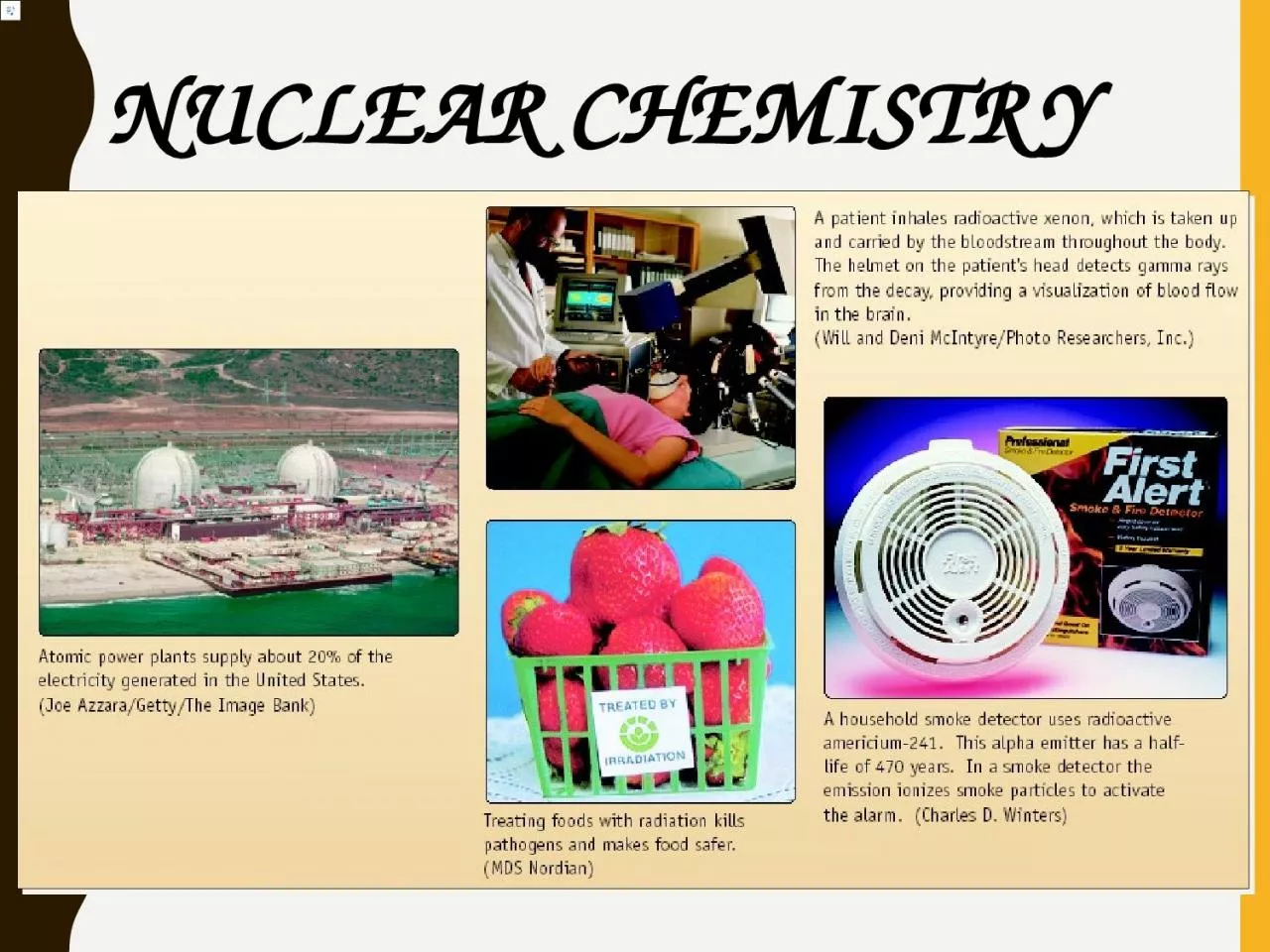

A naturally radioactive element will emit energy without the absorption of energy from an outside source The nucleus of an element becomes radioactive because of an unstable ratio of protons to neutrons in the nucleus ID: 1034343
Download Presentation The PPT/PDF document "Nuclear Chemistry Aim #1: What is Nuclea..." is the property of its rightful owner. Permission is granted to download and print the materials on this web site for personal, non-commercial use only, and to display it on your personal computer provided you do not modify the materials and that you retain all copyright notices contained in the materials. By downloading content from our website, you accept the terms of this agreement.
1. Nuclear Chemistry
2. Aim #1: What is Nuclear Chemistry?A naturally radioactive element will emit energy without the absorption of energy from an outside source. The nucleus of an element becomes radioactive because of an unstable ratio of protons to neutrons in the nucleus.All elements with atomic number greater than 83 (Bi) are unstable and will spontaneously decay.
3. StabilityThe ratio of neutrons to protons in stable nuclei is approximately 1:1Belt of stabilityAtoms with atomic numbers above 82 have no stable isotopes
4. Belt of Stability
5. RadioactivityDiscovered by Marie CurieUnstable nuclei break apart or decayDecaying nuclei release/emit particles and energyAlpha particleBeta particlePositronGamma ray
6. Common Radioactive Emissions (Table O)ParticleMassChargeSymbolPenetrating PowerAlpha(helium)4 amu2 +LowBeta(electron)~0 amu1-ModeratePositron~0 amu1+ModerateGamma(energy)~0 amu0High
7. Penetrating Ability
8. Aim#2: How do we write transmutation reactions?When the nucleus of one element is changed into the nucleus of a different element2 types: Natural transmutation (1 reactant)Artificial transmutation (at least 2 reactants)
9. Natural TransmutationAlpha decayAn alpha particle is emitted
10. Natural Transmutation Beta Decaya beta particle is emitted
11. Natural Transmutation Positron EmissionConversion of a proton to a neutron
12.
13. Sample ProblemWrite a nuclear equation showing what forms when radon-222 decaysStep 1: Determine the type of emission by looking on Table NStep 2: Look up the atomic number of the known element and write an equation showing the known informationStep 3: Subtract the weight and charge of the emission from the weight and charge of the original element to determine the weight and charge of the new elementStep 4: Identify the new element based on the nuclear charge or atomic number
14. Aim# 3: What is Nuclear Energy Produced by a nuclear reaction that converts mass into energy. Produces on the order of a billion times more energy than a chemical reaction
15. Artificial TransmutationHuman made reactions in which a nucleus is bombarded with a high speed particle which causes the nucleus to emit a proton or neutronMay use particle accelerators to give charged particles enough KE to overcome the repulsion that exist between two nuclei At least two reactants Examples:
16. Fission ReactionsThe splitting of a heavy nucleus into two or more lighter nuclei. Nucleus must have a high atomic number, process requires a neutron to collide with the heavy nucleus Nuclear reactors, atomic bomb
17. FissionA chain reaction can occur where the neutrons released by fission of one nucleus trigger fission in another nuclei
18. FissionBenefitsThe fuel lasts longer than fossil fuelsCO2 and smoke products are not produced, therefore not contributing to air pollutionReleases large amounts of energyProblemsFuels and products are radioactivePossibility of a nuclear accident
19.
20. FusionTwo light nuclei combine to form heavier nucleiOccurs in the sunProduces a huge amount of energyHydrogen bomb
21. Fusion, fuelsThe fuels for this reaction are hydrogen isotopes (Hydrogen- 1,2 or 3)H-1 reacts the slowestH-2 is obtained from heavy water and H-3 can be produced in a nuclear reaction
22. FusionBenefitsUse inexpensive, plentiful fuelProduce almost no harmful radioactive wastesProblemsExtremely high activation energy to trigger the reactionExtremely high temperatures, difficult to control
23.
24. Mass DefectFor both fission and fusion reactions, the total mass of the products is less than the total mass of the reactantsMass defect- when matter has been converted into energy
25. The mass of a proton is 1.00728 amu The mass of a neutron is 1.00866 amuCarbon-12 has a mass of exactly 12 amuIf you add up 6 protons and 6 neutrons, you get more than 12 amuThe mass of 6 protons and 6 neutrons is 12.0956 amuThe mass of a carbon nucleus is less than the sum of its parts!!!
26. Uses of RadioisotopesRadioisotopeUseCarbon-14 (C-14)Dating previously living materials, tracerUranium-238 (U-238)Pb- 206Dating rocks, geological formations Phosphorous-31 (P-31)Used in fertilizer to trace the intake of phosphorous by plantsIodine-131 (I-131)Detection and treatment of thyroid conditions
27. RadioisotopeUseCobalt (Co-60)Can be used for treating cancer RadiumCan be used for treating cancerTechnetium-99 (Tc-99)Location of tumors
28. Radiation RisksDifficult to store and dispose of nuclear waste products because of their long half lives
29. How do we solve Half Life problems?Radioactive isotope disintegrate at characteristic rates. The amount of time it takes for half of a radioactive sample to decayTable N!!
30. Sample ProblemIf I initially have 100g of a sample and its half life is 5 seconds, how long will it take for the sample to contain only 3.125 g?How many half lives did the sample undergo?What fraction of the original sample remains?
31. Typical Half Life Graph